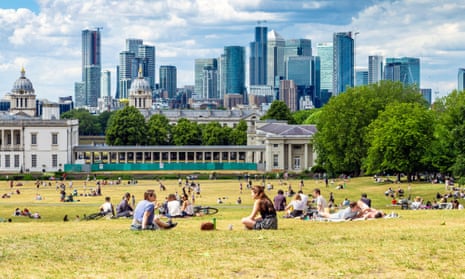When British holidaymakers return from the beaches and a truncated holiday season, some companies will be preparing to welcome back workers too.
After months of Zoom video calls, a number of major businesses are getting ready for a return to (relative) normality. Last week accountancy firm PwC reopened all of its UK offices, while its competitor Deloitte began to allow staff back to some sites in the capital and other regional cities, and employees of law firm Slaughter and May were once again able to opt to work from its London headquarters.
PwC is targeting the end of September for the return of more than 50% of its employees.
“Bringing people together safely is important for teams, good for communities and good for the economy. There is also a mental health benefit for many,” said its chairman, Kevin Ellis. “I see value in people being back in the office.”
However, many other big office occupiers are in no great rush to return to their corporate headquarters, many of which are in central London, as well as cities including Birmingham, Manchester and Glasgow.
Remote working during lockdown has generally been judged a success by the largest banks, accountancy and law firms. As a consequence they aren’t eager to force their staff back on to public transport to reach their desks, which is a particular preoccupation for those based in central London.
The 30 biggest employers in the capital’s financial district, the City of London, only intend to bring between 20% and 40% of workers back to their offices in the coming months, according to the City of London police commissioner, Ian Dyson, with the rest continuing to work remotely.
The tentative return to city centres will have an impact on other sectors of the economy, from transport companies to the smaller businesses that provide services to thousands of office workers.
International employers with a presence in Asia, such as US bank Goldman Sachs and law firm Freshfields, with buildings in London and Manchester, have learned from their experience in the region, which was affected by the coronavirus pandemic earlier than Britain.
Goldman Sachs has allowed staff to voluntarily return to its London headquarters since mid-June and it’s thought that about 10% of the 6,000 workforce has chosen to do so.
When workers reprise the commute and enter their corporate building for the first time in months, many things will feel unfamiliar.
Temperature checks on entry, one-way systems inside the building, limits on how many people can travel in a lift, and wearing of masks in communal areas have all made their mark on the corporate environment.
Some firms are thought to be considering whether to offer antibody testing to their staff, although the accuracy of some tests is disputed.
Many physical safety measures can be more easily introduced by companies who are the sole occupier of their building, as they can control the environment and better manage the wellbeing of their workforce.
Property consultant Tony Lorenz has seen demand for “self-contained buildings” come back into fashion among his clients.
Firms based in skyscrapers may also find the transition back to work more challenging, if only a small number of people are permitted to ride together in a lift.
The chief executive of Barclays, Jes Staley, which occupies a 33-storey high-rise in east London’s Canary Wharf district, said in April “the notion of putting 7,000 people in a building may be a thing of the past”.
The main focus for businesses is “the ability to provide a safe office environment for staff, as well as staff concerns around using public transport,” according to Miles Celic, chief executive of financial lobby group TheCityUK.
“While localised outbreaks remain a possibility, many firms will either take a slow and phased approach to returning to the office or continue to take a wait-and-see approach for the foreseeable future,” Celic added.
How workers travel to the office is a major consideration for London-based firms, where the vast majority of workers are used to cramming into trains and buses during their daily commute, and not all can choose to drive, walk or cycle instead.
For one financial firm in Canary Wharf, where in regular times thousands of people pour from the underground station to gleaming towers during a couple of hours each morning and evening, staggering start and finish times for employees will not make much difference.
Many corporations believe the stigma of remote working has disappeared during the pandemic, and some expect companies to retain working from home for some of the time.
Over the coming months, businesses are expected to reconsider whether they still require the same amount of expensive office space as they did before Covid-19.
Even as lockdown restrictions ease, city centre streets that once thronged with busy workers remain empty, hurting the small service businesses who rely on footfall to drive trade, including sandwich shops, coffee carts and dry cleaners.
“It’s not going too well,” said Aida Xhameni, who runs Alfredo’s sandwich shop, just a few streets from the Bank of England, with her husband.
Trade hasn’t picked up in the month since Alfredo’s reopened, and is the worst Xhameni has seen in 15 years of business. “We’re making about a quarter of what we did before,” she said.
For Alfredo’s and many other small businesses, a return to office working can’t come soon enough, although they may be waiting some time.
